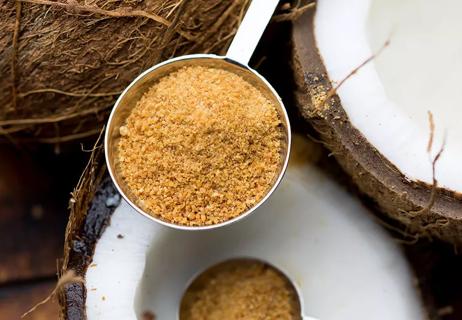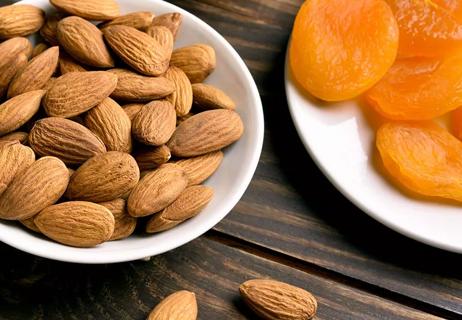Don’t skip meals or go ‘cold turkey’ — eat a balanced diet and talk to your doctor instead

Sugar is pretty amazing. It’s the purest form of energy available to us and — unlike fats and proteins — can actually cross the blood-brain barrier. Sugar quite literally feeds your brain. And it tastes great, too!
Advertisement
Cleveland Clinic is a non-profit academic medical center. Advertising on our site helps support our mission. We do not endorse non-Cleveland Clinic products or services. Policy
We need sugar to live. But we don’t need added sugar.
But for some of us, it feels like we need sugar. Desperately. In fact, researchers have found that sugar lowers both opioid and dopamine receptor availability in our brains. Put simply, sugar activates the reward and pleasure centers of our brains the same way addictive substances do.
It’s no wonder we consume so much of the stuff. According to the American Heart Association, the average American adult eats somewhere between 22 and 30 teaspoons worth of added sugar in a day. Women and children should only be eating about 6 teaspoons (25 grams) of sugar a day; men’s intake should only be slightly higher, at 9 teaspoons (36 grams). Nine teaspoons of sugar may sound like a lot (and it is), but it’s also what you’ll drink in an average 12-ounce can of soda.
Reducing your sugar intake can be a positive step toward improving your overall health. It can help with digestive issues like irritable bowel and acid reflux, but that’s not all. Eating less sugar can also improve anxiety and stress, reduce fatigue, ease joint pain, and cut down on headaches and migraines. According to the American Heart Association, 8 out of 10 adults are trying to reduce the amount of sugar they eat, but it’s not easy. For people who’ve become chemically dependent on sugar, it’s even harder.
Advertisement
We spoke to registered dietitian Beth Czerwony, RD, LD, about what sugar addiction is — and what to do if you feel like your sugar cravings are out of control.
Plenty of people have a sweet tooth, so how do you know if you’re addicted to sugar? Is there an invisible threshold that you cross between cookie number one and cookie number two?
You can’t be diagnosed with a sugar addiction, at least not yet. But self-reflection and an honest conversation with a healthcare provider is the best way to start to get a handle on the issue.
According to Czerwony, the key features of sugar addiction are volume, frequency and feelings.
Ask yourself these questions:
If you’re answering “yes,” chances are you are dealing with dependency.
It’s even more likely if you’re attempting to get or stay sober in other areas of your life. “People that have struggled with an addiction to alcohol, for example, will often turn to sweets to replace it,” Czerwony notes. “So, sugar addiction really is a chemical imbalance.”
Unaddressed, Czerwony says the long-term consequences can include elevated risks of:
Unlike many other substance use disorders, your body needs sugar. It just doesn’t need added sugars. That makes managing your sugar dependence a bit tricky — abstaining from the stuff is impossible.
When it comes to breaking a sugar addiction, there’s no quick fix. You’re making a significant lifestyle change, and it will take time and effort. We’ve compiled a list of the mental, physical and dietary changes that will help you fend off sugar cravings and help you manage your eating habits.
Sometimes, the best advice is also the most obvious.
“If you’re getting in the recommended five servings of fruits and vegetables a day, protein and high-fiber foods, it will help stabilize your blood sugar,” Czerwony says.
As you build a balanced diet, be aware that there are added sugars lurking in most highly processed foods. This means that you may be eating a lot more sugar than you realize.
Whether it’s a side effect of a busy life or a conscious choice, skipping meals opens the door to sugar cravings.
Advertisement
It happens to all of us from time to time. “If you don’t eat all day because you’re busy or you’re not hungry, you’ll be way past hungry by the time you get home. You’ll end up having one big meal right before bed or stopping at a drive-thru.”
Eating nourishing food consistently throughout the day prevents you from getting too hungry, which enables you to make better food choices.
“It’s tough,” Czerwony concedes, “but nowadays, we have all kinds of meal replacement shakes and bars, convenience cheese sticks and yogurts — those types of things.” There are also lots of fast food alternatives now, like meal prep kits and healthy heat-and-eat subscription services.
Improvising tends not to work out very well for those of us with a raging sweet tooth, whether we’re at the grocery store or standing in front of the fridge.
“Not everybody’s a home chef,” Czerwony says, “and that’s OK. But it’s important to invest the time to plan a grocery list, buy meal prep-friendly foods and healthy snacks and know what you’re going to have each day of the week — it’s about getting into that pattern.”
Stress hormones play a big role in sugar cravings. Exercise is a proven stress reducer and a great way to calm sweet cravings.
Advertisement
“Exercise will help decrease your ghrelin levels. It can also help you to be more tired, get to sleep and stay asleep a little bit longer, which also reduces cravings,” Czerwony explains.
Exercise doesn’t have to be vigorous to be helpful, either.
“Everybody’s level of athleticism and pain tolerance is different,” Czerwony notes. “I never tell people they have to hop on the treadmill. If you have fibromyalgia, for example, and can’t run, let’s do some seated exercises, or let’s go for a light walk. Whatever you’re able to do.
“Things like yoga, Tai Chi, light stretching — they’ll help, too. Just moving your body will help you reduce those stress hormones.”
She adds that when we’re investing time and effort in intentional movement, we tend to be more mindful about what we eat.
We already know that a good night’s sleep is crucial to our health. But not nearly enough of us realize how connected our sleep habits are to our sugar cravings.
We have two hormones in our stomach: leptin and ghrelin. Leptin signals to our brain that we’re full. Ghrelin, on the other hand, sends the message that we’re hungry.
“Your ghrelin levels increase when you don’t have good sleep,” Czerwony explains. “So, you find yourself waking up and saying ‘I want that donut’ instead of having a balanced breakfast.”
Advertisement
It’s harder to make good choices when you’re tired, and even harder to pass up the short-term energy boost sugary foods offer. Being well-rested will reduce your sugar cravings and — when they do happen — make them easier to ignore.
Sometimes, we think we’re hungry … and really, we’re just thirsty.
Czerwony emphasizes that hydration is especially important when you’re trying to kick a sugar habit. “If we have concentrated sugar in our bloodstreams,” she explains, “you can dilute that down with the water.” That will help reduce blood sugar peaks and valleys, which, in turn, helps keep cravings managed.
Do you grab a candy every time you walk past your co-worker’s candy bowl? Or help yourself to the leftover bits of toaster pastry that your kid leaves in the morning? Do you always order a margarita at that one great hole-in-the-wall restaurant?
It’s really easy to eat (or overeat) sweets without realizing it — especially, Czerwony notes, if you’re grazing or mindlessly snacking.
You might want to consider food journaling. “We can manage what we monitor,” Czerwony states. “If we don’t realize what we’re doing, we can’t manage it.”
If you have a history of anorexia or bulimia, food journaling might be a trigger. If that’s the case for you, either skip this tip or try adjusting your approach. Instead of noting the amount of food eaten and calories consumed, for example, try checking off a box every time you eat a serving of vegetables or drink 8 ounces of water.
If you peruse the World Wide Web, you’ll see plenty of people claiming that you’ll feel so much better if you just stop eating [fill in the blank]. Czerwony isn’t convinced.
“Certainly, if you have a lactose intolerance or an allergy, consider eliminating dairy. If you have a gluten intolerance or celiac disease, consider eliminating gluten. But don’t cut out food groups that aren’t harming you,” she says. “If you do, you’ll have to really focus then on getting the calcium, the magnesium and the vitamin D that you’re lacking as a result. That doesn’t serve us well and sets us up for failure.”
Oh, the internet. It has so much information and advice to offer — and so much of it is contradictory. The value of sugar detoxing is one of those topics.
Let’s start by defining our terms. A sugar detox involves cutting all added sugars from your diet for a set period of time, from as little as a week to as long as a month. The premise is that, after an initial period of “withdrawal,” you’ll no longer crave sweets the way you do now.
The approach works for some (lucky) people, but it’s not the best call for most of us. Detoxing makes sense if you have an addiction to a dangerous substance, but we consume sugar every day in one form or another, so you’re never truly cutting it out of your diet. You’re just dramatically reducing your intake.
“I’m not a fan of going ‘cold turkey,’” Czerwony cautions. “I think that it’s abrupt. And that anything that’s too rapid is not going to work long term.
“If you do a sugar detox, you could get hangry. You could get upset. And the first thing you’re going to do is reach for something sweet to make yourself feel better. You’re more likely to stick with a new behavior if you’re making smart choices and small, reasonable behavioral changes over time.”
According to Czerwony, sugar detoxing isn’t helpful for most folks. “Some people are able to rip the Band-Aid™ off and move on,” she says, “but for the majority of people, that’s just not a healthy way to look at it. You’ll relapse into you’re old behaviors, feel ashamed that you couldn’t quit sugar and then you’re going to try again. You’re setting yourself up for a bad cycle.”
If you feel like your sweet tooth is taking over your life, Czerwony advises that enlisting the support of your primary care doctor or a healthcare provider is an important step to take.
“The first line of defense is having an open and honest conversation with your healthcare provider,” she says. “That way you really can get ahold of the issue.”
That conversation will probably lead to the provider ordering some lab work.
“They really need to see what you’re working with,” she continues. “Do you have elevated blood sugar? Do you have elevated lipids? If you do, that needs to be addressed and taken care of, which may require prescription medication.”
Czerwony also notes that there are anti-obesity medications on the market that help decrease appetite and cravings for sweets. Not all providers are willing to prescribe those medications, but it’s a conversation worth having.
“If your primary care doctor isn’t comfortable addressing this issue, or if you feel that you more specific care, see a dietitian.”
If your feel like your sweet tooth is becoming a problem, physically or mentally, you’re not alone — and it’s not all in your head. For some of us, a few lifestyle changes will be enough to break our sugar addiction. Others will need medical intervention to overcome the chemical reactions fueling the craving. Whatever your situation, being kind to yourself and open with your healthcare provider can only help.
Learn more about our editorial process.
Advertisement

A high-sugar diet can trigger a chain reaction that may raise your risk

You can reduce how much added sugar you consume by tracking what you eat, reading labels and limiting portions of the sweet stuff

A high intake of sugar can cause an increase in ‘bad’ cholesterol and a decrease in ‘good’ cholesterol

Often labeled as ‘diabetes-friendly’ or ‘calorie-free,’ these sugar substitutes warrant caution

There is an indirect link between the sweet substance and the condition

It’s touted as a healthier alternative to cane sugar, but basically, well ... it’s still just sugar

Sugary foods don’t always taste sweet, and they may not say ‘sugar’ on the label

Fuel your body with healthy options that combine fiber-rich carbs, lean protein and healthy fats

Start having sex about 72 hours before ovulation, then at least every other day during your fertile window

Attachment theory suggests that your earliest relationships shape connections throughout your life

It isn’t a recognized mental health disorder, but research shows that problematic social media use can negatively affect your mental health, self-esteem and sleep